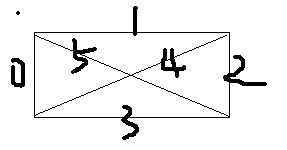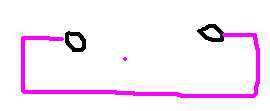#include<cstdio>
#include<cstring>
#include<iostream>
#include<algorithm>
#define ok { puts("Y"); continue; }
using namespace std;
#define N 100001
int L[N<<2],R[N<<2];
struct node
{
bool a[6],b[2];
void clear() { memset(a,false,sizeof(a)); memset(b,false,sizeof(b)); }
node operator + (node p) const
{
node tmp;
tmp.clear();
tmp.a[0]=a[0];
tmp.a[0]|=a[1]&&a[3]&&b[0]&&b[1]&&p.a[0];
// cout<<tmp.a[0];
tmp.a[1]=a[1]&&b[0]&&p.a[1];
tmp.a[1]|=a[5]&&b[1]&&p.a[4];
// cout<<tmp.a[1];
tmp.a[2]=p.a[2];
tmp.a[2]|=p.a[1]&&p.a[3]&&b[0]&&b[1]&&a[2];
// cout<<tmp.a[2];
tmp.a[3]=a[3]&&b[1]&&p.a[3];
tmp.a[3]|=a[4]&&b[0]&&p.a[5];
// cout<<tmp.a[3];
tmp.a[4]=a[4]&&b[0]&&p.a[1];
tmp.a[4]|=a[3]&&b[1]&&p.a[4];
// cout<<tmp.a[4];
tmp.a[5]=a[1]&&b[0]&&p.a[5];
tmp.a[5]|=a[5]&&b[1]&&p.a[3];
// cout<<tmp.a[5];
tmp.b[0]=p.b[0]; tmp.b[1]=p.b[1];
return tmp;
}
};
node tr[N<<2];
void read(int &x)
{
x=0; char c=getchar();
while(!isdigit(c)) c=getchar();
while(isdigit(c)) { x=x*10+c-‘0‘; c=getchar(); }
}
void build(int k,int l,int r)
{
L[k]=l; R[k]=r;
if(l==r)
{
tr[k].a[1]=tr[k].a[3]=true;
return;
}
int mid=l+r>>1;
build(k<<1,l,mid);
build(k<<1|1,mid+1,r);
}
void change(int k,int pos,bool ty,int line,bool how)
{
if(L[k]==R[k])
{
if(!ty)
{
if(line==1)
{
tr[k].b[0]=how;
if(tr[k].b[0] && tr[k].a[0]) tr[k].a[5]=true;
else if(!tr[k].a[0]) tr[k].a[5]=false;
}
else
{
tr[k].b[1]=how;
if(tr[k].b[1] && tr[k].a[0]) tr[k].a[4]=true;
else if(!tr[k].a[0]) tr[k].a[4]=false;
}
}
else
{
tr[k].a[0]=tr[k].a[2]=how;
tr[k].a[4]=tr[k].a[5]=how;
}
return;
}
int mid=L[k]+R[k]>>1;
if(pos<=mid) change(k<<1,pos,ty,line,how);
else change(k<<1|1,pos,ty,line,how);
tr[k]=tr[k<<1]+tr[k<<1|1];
}
node query(int k,int l,int r)
{
if(L[k]>=l && R[k]<=r) return tr[k];
int mid=L[k]+R[k]>>1;
if(r<=mid) return query(k<<1,l,r);
if(l>mid) return query(k<<1|1,l,r);
node ll=query(k<<1,l,r),rr=query(k<<1|1,l,r);
return ll+rr;
}
int main()
{
// freopen("bzoj_1018.in","r",stdin);
// freopen("bzoj_1018.out","w",stdout);
int n; read(n);
build(1,1,n);
char c[7];
int lx,ly,rx,ry;
int cnt=0;
while(scanf("%s",c)!=EOF)
{
if(c[0]==‘E‘) return 0;
read(lx); read(ly); read(rx); read(ry);
if(ly>ry) swap(lx,rx),swap(ly,ry);
if(c[0]==‘O‘ || c[0]==‘C‘)
{
if(lx==rx) change(1,ly,0,lx,c[0]==‘O‘);
else change(1,ly,1,lx,c[0]==‘O‘);
}
else
{
node tmp=query(1,ly,ry);
if(ly==ry && tmp.a[0]) ok
else if(ly!=ry)
{
if(lx==1 && rx==1 && tmp.a[1]) ok
if(lx==2 && rx==2 && tmp.a[3]) ok
if(lx==1 && rx==2 && tmp.a[5]) ok
if(lx==2 && rx==1 && tmp.a[4]) ok
}
node l=query(1,1,ly);
node r=query(1,ry,n);
if(lx==1 && rx==1)
{
if(l.a[2]&&tmp.a[4]) ok
if(r.a[0]&&tmp.a[5]) ok
if(l.a[2]&&r.a[0]&&tmp.a[3]) ok
}
else if(lx==1 && rx==2)
{
if(l.a[2]&&tmp.a[3]) ok
if(r.a[0]&&tmp.a[1]) ok
if(l.a[2]&&r.a[0]&&tmp.a[4]) ok
}
else if(lx==2 && rx==1)
{
if(l.a[2]&&tmp.a[1]) ok
if(r.a[0]&&tmp.a[3]) ok
if(l.a[2]&&r.a[0]&&tmp.a[5]) ok
}
else
{
if(l.a[2]&&tmp.a[5]) ok
if(r.a[0]&&tmp.a[4]) ok
if(l.a[2]&&r.a[0]&&tmp.a[1]) ok
}
puts("N");
}
}
}
有一天,由于某种穿越现象作用,你来到了传说中的小人国。小人国的布局非常奇特,整个国家的交通系统可
以被看成是一个2行C列的矩形网格,网格上的每个点代表一个城市,相邻的城市之间有一条道路,所以总共有2C个
城市和3C-2条道路。 小人国的交通状况非常槽糕。有的时候由于交通堵塞,两座城市之间的道路会变得不连通,
直到拥堵解决,道路才会恢复畅通。初来咋到的你决心毛遂自荐到交通部某份差事,部长听说你来自一个科技高度
发达的世界,喜出望外地要求你编写一个查询应答系统,以挽救已经病入膏肓的小人国交通系统。 小人国的交通
部将提供一些交通信息给你,你的任务是根据当前的交通情况回答查询的问题。交通信息可以分为以下几种格式:
Close r1 c1 r2 c2:相邻的两座城市(r1,c1)和(r2,c2)之间的道路被堵塞了;Open r1 c1 r2 c2:相邻的两座城
市(r1,c1)和(r2,c2)之间的道路被疏通了;Ask r1 c1 r2 c2:询问城市(r1,c1)和(r2,c2)是否连通。如果存在一
条路径使得这两条城市连通,则返回Y,否则返回N;
第一行只有一个整数C,表示网格的列数。接下来若干行,每行为一条交通信息,以单独的一行“Exit”作为
结束。我们假设在一开始所有的道路都是堵塞的。我们保证 C小于等于100000,信息条数小于等于100000。





